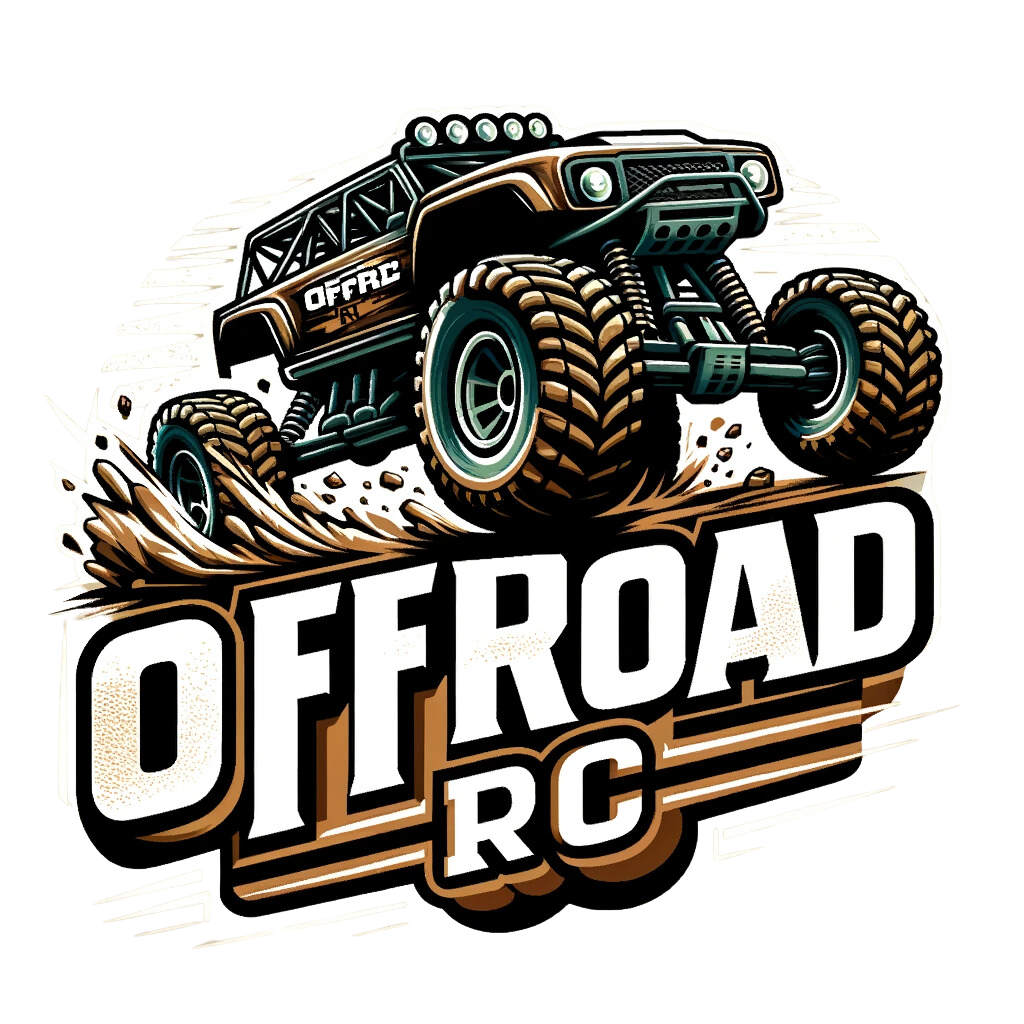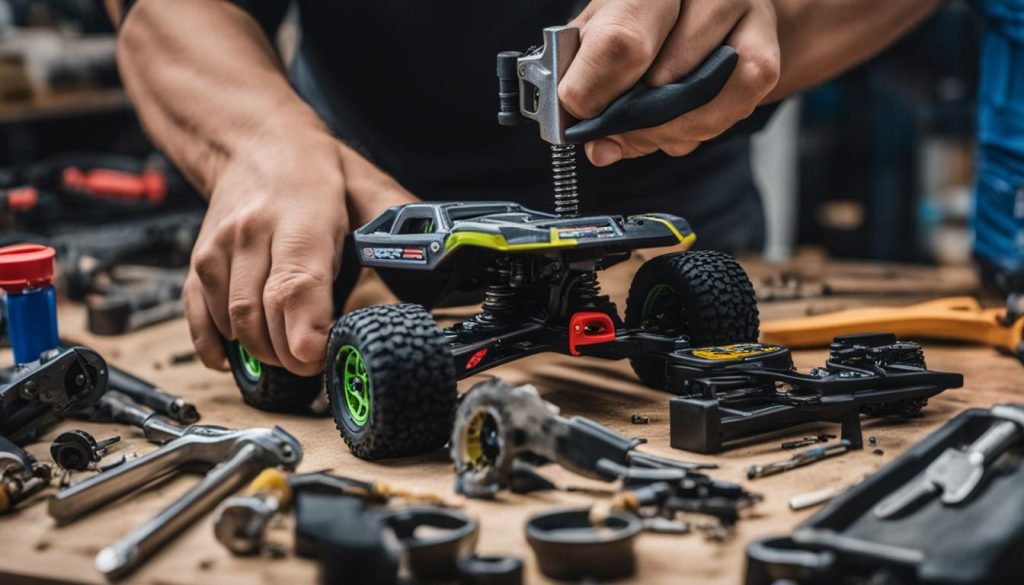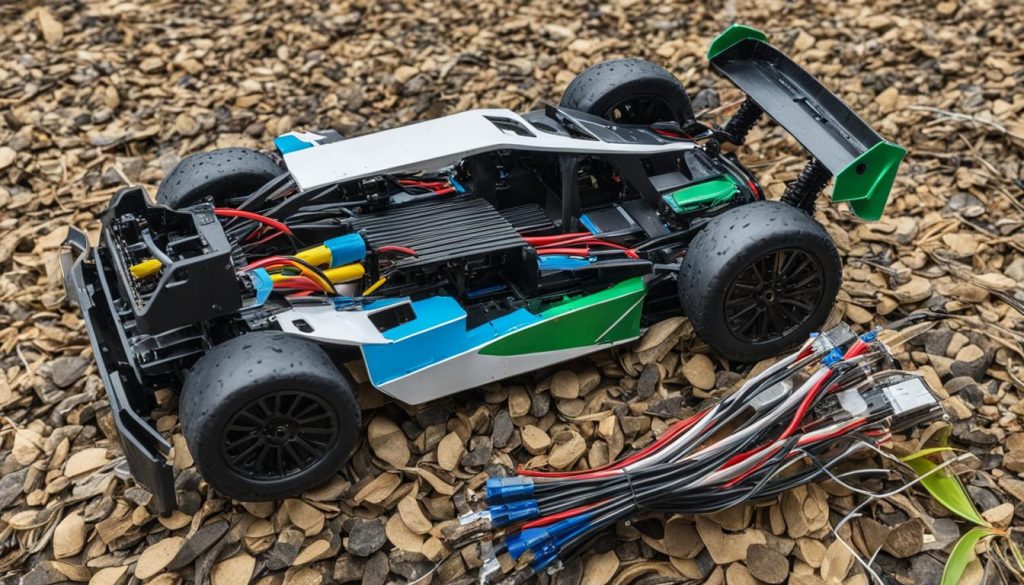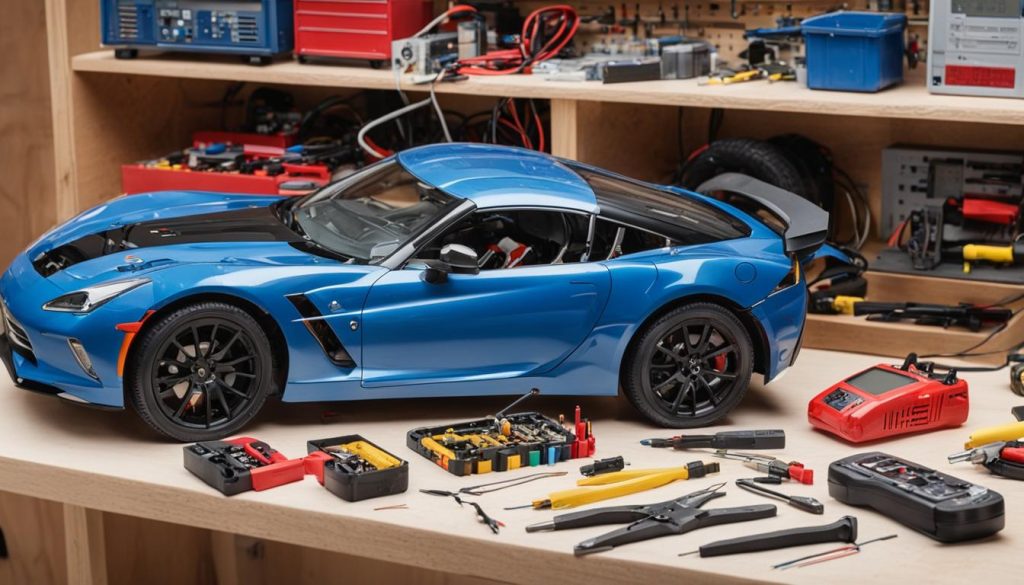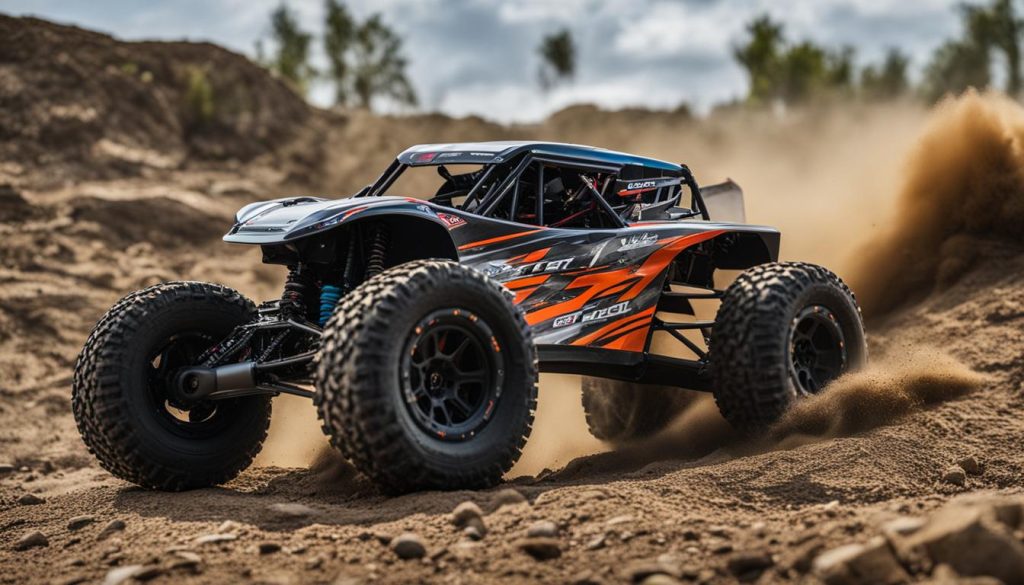With their high-speed capabilities and rugged designs, off-road RC cars are a thrilling hobby for enthusiasts of all ages. However, like any mechanical device, these vehicles may require occasional repairs and maintenance. In this comprehensive DIY guide, we will provide you with step-by-step instructions on how to repair off-road RC cars at home. Whether you need to fix a specific issue or perform general maintenance, we have you covered.
Off-road RC car repair tips can save you time and money while ensuring that your vehicle stays in optimal condition. From troubleshooting common problems to choosing the right parts and understanding the intricacies of electric motors and battery options, this guide will equip you with the knowledge and skills to tackle any repair challenge.
Key Takeaways
- Learn how to repair off-road RC cars at home with step-by-step instructions.
- Choose the right RC car brand based on factors such as speed, durability, and quality.
- Understand the different types of off-road RC cars for various terrains and purposes.
- Consider the advantages and disadvantages of electric and nitro-powered RC cars.
- Explore the differences between brushed and brushless motors, and choose the right one for your needs.
Choosing the Right RC Car Brand
When it comes to off-road RC cars, you have a variety of brands to choose from. Each brand offers unique features and qualities that cater to different preferences and budgets. Consider the following popular off-road RC car brands:
1. Traxxas
Traxxas is renowned for its exceptional speed, durability, and high-quality construction. With a wide range of models to choose from, Traxxas offers top-notch performance for off-road enthusiasts.
2. Exceed
Exceed offers more affordable options for off-road RC cars, making it an attractive choice for those on a budget. However, these models may require more maintenance and care compared to higher-end brands.
3. HPI
HPI is known for manufacturing off-road RC cars with good quality parts and durability. Their models are designed to withstand rigorous off-road conditions, ensuring a long-lasting and exciting experience.
4. Tamiya
Tamiya is another popular brand that offers a wide range of off-road RC cars. Their models are known for their durability, quality, and excellent availability of spare parts. Tamiya is a reliable choice for off-road enthusiasts.
5. Team Associated
Team Associated is a brand that offers different options for off-road RC cars. They provide a variety of models suitable for various skill levels, from beginners to advanced users.
6. Losi
Losi is a brand renowned for its innovation and high-performance off-road RC cars. They offer a selection of models that cater to different terrains and preferences, ensuring an enjoyable off-road experience.
When choosing the right RC car brand, consider your budget, desired features, and availability of spare parts. Each brand mentioned above has its own strengths and unique offerings, so take the time to research and find the brand that aligns with your needs.
Understanding Different Types of Off-Road RC Cars
Off-road RC cars offer a wide range of types, each designed for specific purposes and terrain capabilities. Whether you crave speed on paved surfaces, want to slide around turns, or tackle rugged off-road tracks, there is a type of off-road RC car that’s perfect for you.
Street Cars
Street cars are built for speed and excel on paved, flat surfaces. Equipped with low-profile tires and advanced suspension systems, these RC cars can reach impressive speeds while maintaining control and stability.
Drift Cars
For those who enjoy the thrilling challenge of sliding around turns, drift cars are the ideal choice. These RC cars resemble on-road cars but feature slick tires that allow for controlled drifting. With their exceptional handling and precise control, drift cars provide a unique and exhilarating experience.
Buggies
Buggies are a hybrid of off-road and on-road RC cars, making them versatile for various terrains. With their off-road capabilities and durable construction, buggies can handle both dirt tracks and flat surfaces. These all-terrain vehicles offer a well-rounded performance for RC enthusiasts.
Truggies
Truggies combine the best of both worlds, featuring monster truck tires for superior off-road performance. With their robust suspension systems and powerful motors, truggies can handle rough terrains with ease, including gravel, grass, and dirt tracks. If you enjoy the thrill of off-road adventures, truggies are a great option.
Trucks
If you prefer rugged outdoor environments like woods or grass, off-road trucks are purpose-built for these challenging conditions. With their large wheels, high ground clearance, and sturdy construction, off-road trucks provide excellent traction and stability, allowing you to conquer any off-road obstacle.
If you are looking for an off-road RC car, consider the terrain and the type of driving experience you desire. Whether it’s speed, drifting, or off-road adventures, there is a perfect type of off-road RC car to fulfill your adrenaline-fueled dreams.
Stay tuned for the next section where we will discuss the pros and cons of choosing between electric and nitro-powered RC cars.
Choosing Between Electric or Nitro RC Cars
When it comes to deciding between electric and nitro RC cars, you have a few key factors to consider. Each type has its own advantages and disadvantages, so it’s important to weigh your options and make an informed decision based on your preferences and needs. Here, we’ll explore the pros and cons of both electric and nitro RC cars to help you choose the right one for you.
Advantages of Electric RC Cars:
- Cost: Electric RC cars are generally more affordable than their nitro counterparts.
- Maintenance: Electric RC cars require less maintenance compared to nitro cars, making them easier to maintain and repair at home.
- Suitability for At-Home Use: Electric RC cars are well-suited for indoor and backyard use, as they produce no exhaust fumes and are quieter than nitro cars.
Advantages of Nitro RC Cars:
- Longer Run Times: Nitro RC cars offer longer run times compared to electric cars, allowing for extended play sessions before refueling.
- Realistic Experience: Nitro RC cars mimic the experience of driving a real car, with the sound and smell of a real engine.
However, it’s important to note that nitro RC cars also have some disadvantages:
- Higher Costs: Nitro RC cars tend to be more expensive upfront, and ongoing costs can include fuel, glow plugs, and other maintenance supplies.
- Complexity: Nitro engines require more intricate setup and tuning, making them more challenging for beginners.
- Maintenance: Nitro engines need regular cleaning and tuning to maintain optimal performance.
Ultimately, your choice between electric and nitro RC cars depends on your budget, level of experience, and the type of experience you want. Electric cars are a great option for beginners or those who prefer a more affordable and low-maintenance option. On the other hand, if you crave the realism and longer run times that nitro cars offer, and don’t mind the additional costs and complexities, then a nitro RC car might be the perfect fit for you.
“When deciding between electric and nitro RC cars, consider your budget, level of experience, and the type of experience you want.”
| Electric RC Cars | Nitro RC Cars |
|---|---|
| Affordable | Longer run times |
| Low maintenance | Realistic experience |
| Well-suited for at-home use | Higher upfront and ongoing costs |
| Complex setup and tuning |
Understanding Electric Motors and ESC
When it comes to electric RC cars, the type of motor used plays a crucial role in performance. There are two main types of motors: brushed motors and brushless motors.
Brushed motors are the more affordable option. They use carbon brushes to deliver power to the motor’s spinning rotor. While they are budget-friendly, brushed motors are less efficient and less powerful compared to their brushless counterparts.
In contrast, brushless motors offer superior performance and durability. These motors utilize a more advanced design, with a permanent magnet rotor and electronically controlled commutation. Brushless motors operate more efficiently, resulting in higher speeds and longer run times.
To control the speed and direction of the motor, an Electronic Speed Controller (ESC) is necessary. The ESC acts as the intermediary between the motor and the throttle input from your RC car’s transmitter. It converts the electrical signals from the transmitter into the appropriate power output for the motor.
The main difference between brushed and brushless motors lies in their construction and performance. Brushed motors have simple internal components with brushes that wear down over time, requiring occasional maintenance. On the other hand, brushless motors feature a more complex design that eliminates the need for brushes, resulting in a smoother and more efficient operation.
Here is a table summarizing the key differences between brushed and brushless motors:
| Brushed Motors | Brushless Motors |
|---|---|
| Less expensive | More expensive |
| Less efficient | More efficient |
| Less powerful | More powerful |
| Require occasional maintenance | Low maintenance |
While brushed motors are suitable for entry-level or budget-friendly RC cars, many enthusiasts opt for brushless motors for their superior performance and longevity.
Choosing the Right Brushless Motor
When it comes to upgrading your RC car to a brushless motor, you have several reputable brands to choose from. Hobbytron, Mamba Max, and Sidewinder are well-known and trusted in the industry. These brands offer a range of brushless motors that will enhance the performance of your RC car.
Understanding the motor ratings is crucial when selecting the right brushless motor for your needs. Two important ratings to consider are “kv” and “t.” The “kv” rating represents the motor’s revolutions per minute per volt, determining the speed of your car. The higher the kv rating, the faster your RC car will go. The “t” rating indicates the suitability of the motor for either off-road or on-road driving. A lower “t” rating is more suitable for off-road driving, providing better torque and control.
When choosing a brushless motor, it’s essential to consider your specific needs and budget. Select a motor that is compatible with your RC car model and offers the desired performance. Additionally, ensure that the brushless motor and Electronic Speed Controller (ESC) combo are compatible, as they work together to provide optimal power and control.
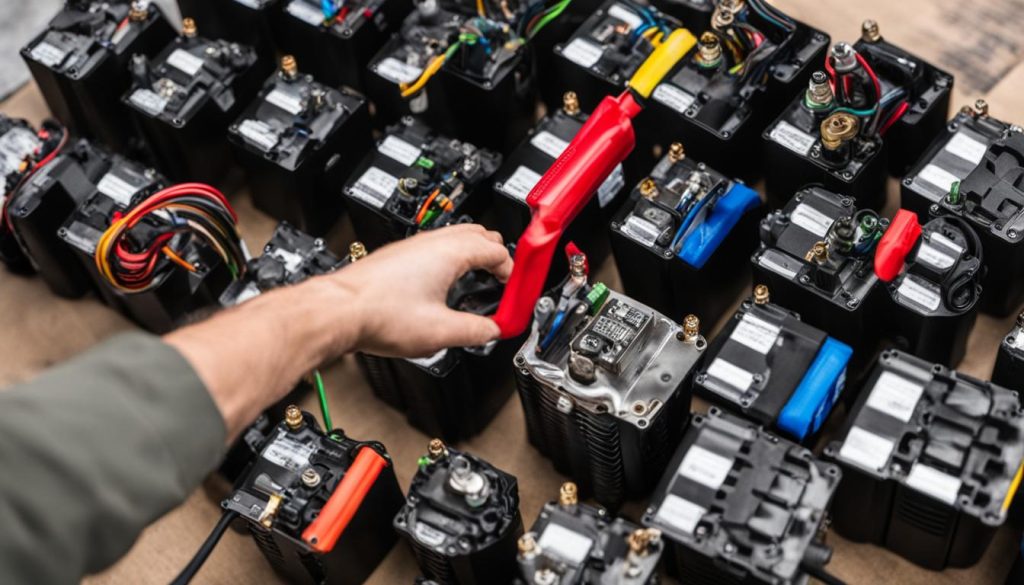
| Brand | Features | Price Range |
|---|---|---|
| Hobbytron | Wide range of options, high-quality, reliable | $$ |
| Mamba Max | Powerful, durable, advanced performance | $$$ |
| Sidewinder | Good balance of price and performance, reliable | $$ |
Table: Brushless Motor Ratings
| Rating | Explanation |
|---|---|
| kv | Rotations per minute per volt (higher kv = faster speed) |
| t | Suitability for off-road or on-road driving (lower t = better torque for off-road) |
Exploring the Electric Car Layout
Understanding the layout of electric RC cars is crucial for repairing and maintaining your vehicle. One popular model, the Exceed 1/10th scale, features a specific layout that includes various components. Familiarize yourself with these parts and their placement to ensure effective maintenance and troubleshooting.
The key components of the electric RC car layout are:
1. Motor
The motor is responsible for powering the RC car and determining its speed and performance. It is essential to understand the type and specifications of the motor installed in your RC car model.
2. ESC (Electronic Speed Controller)
The ESC regulates the speed and direction of the motor based on the input from the transmitter. It is a crucial component that ensures smooth control of your RC car.
3. Battery Pack
The battery pack provides the necessary power for the motor and other electronic components of the RC car. Understanding the type, capacity, and proper handling of the battery pack is important for optimizing performance.
4. Receiver
The receiver acts as the intermediary between the transmitter and the various electronic components of the RC car. It receives the signals from the transmitter and translates them into actions for the motor, ESC, and servos.
5. Servos
Servos are essential for controlling the steering and other movable parts of the RC car. They translate the signals from the receiver into precise movements, allowing you to control the direction and maneuverability of your vehicle.
It is recommended to consult the user manual specific to your RC car model for detailed information and diagrams illustrating the layout and placement of these components. This will provide you with a comprehensive understanding of your RC car’s design and help you navigate the repair and maintenance process effectively.
Below is a visual representation of the electric RC car layout:
| Component | Description |
|---|---|
| An image illustrating the electric RC car layout. |
Choosing Between LiPo and Ni-Mh Batteries
When it comes to powering your RC car, you have two main choices: LiPo (Lithium Polymer) batteries and Ni-Mh (Nickel-Metal Hydride) batteries. Each type has its own advantages and disadvantages, so it’s important to consider your needs and preferences before making a decision.
LiPo Batteries
LiPo batteries are known for their high energy density, which translates to longer run times and more power for your RC car. They are lighter and more compact than Ni-Mh batteries, making them ideal for vehicles where weight and space are a concern.
However, LiPo batteries require proper handling and maintenance due to their potential to explode or catch fire if mishandled. It’s important to always follow the manufacturer’s guidelines and store, charge, and handle LiPo batteries with care.
Ni-Mh Batteries
Ni-Mh batteries, on the other hand, are generally considered safer and more forgiving when it comes to handling. They are also more affordable than LiPo batteries, making them a popular choice for beginners or budget-conscious RC car enthusiasts. However, Ni-Mh batteries typically have lower power density and shorter run times compared to LiPo batteries.
Advantages and Disadvantages
To summarize, here are the advantages and disadvantages of LiPo and Ni-Mh batteries:
- LiPo Batteries:
- + Longer run times
- + More power
- + Lightweight and compact
- – Requires careful handling
- – Can be more expensive
- Ni-Mh Batteries:
- + Safer to handle
- + More affordable
- – Lower power density
- – Shorter run times
Battery Pack Ratings
When selecting a battery pack for your RC car, two important ratings to consider are the capacity (mAh) and power delivery (C rating). The capacity indicates the amount of charge the battery can hold, with higher mAh ratings providing longer run times.
The C rating, on the other hand, represents the battery’s power delivery capability. A higher C rating means the battery can discharge more current, resulting in higher acceleration and overall performance.
Troubleshooting Common RC Car Issues
RC cars can encounter various issues that may affect their performance. By troubleshooting common problems, you can diagnose and fix many of these issues at home. Let’s take a look at some of the most common RC car problems and how to address them.
Faulty On/Off Switch
If your RC car fails to power on or off, the on/off switch may be the culprit. To test the switch, use a multimeter to check for continuity in the on or off position. If the switch fails the continuity test, it’s time to replace it. Consult your user manual or manufacturer’s website for guidance on finding a compatible replacement switch.
Dead or Improperly Installed Batteries
When your RC car doesn’t respond to the controls, it could be due to dead batteries or incorrect installation. Start by checking the battery voltage with a multimeter and replace any dead batteries. Ensure that the batteries are properly inserted in the battery compartment, adhering to the correct polarity. If the problem persists, clean the battery contacts to ensure a proper connection.
Loose or Broken Wires
Loose or broken wires can result in intermittent power loss or a complete malfunction of your RC car. Inspect the wiring harness for any loose or detached connections. Use a soldering iron to reattach any loose wires or replace broken wires as needed. Ensure that all connections are secure and properly insulated to prevent further issues.
Slipped Gears
If your RC car experiences a sudden loss of power or strange noises, the gears may have slipped. Inspect the gear assembly and check for any signs of misalignment or damage. If necessary, reposition the gears or replace them if they are worn out. Proper lubrication of the gears is also important to ensure smooth operation.
Maintenance Tips
To prevent common RC car problems and minimize the need for troubleshooting, regular maintenance is key. Here are a few tips to keep your RC car in top shape:
- Clean your RC car after every use to remove dirt and debris.
- Regularly inspect and tighten screws and fasteners to prevent loosening during operation.
- Check the suspension and shocks for signs of wear or leaks and replace them if necessary.
- Lubricate moving parts and gears with appropriate RC car lubricants to reduce friction and ensure smooth operation.
- Store your RC car in a dry and clean environment to prevent moisture damage.
By following these troubleshooting tips and practicing proper maintenance, you can keep your RC car running smoothly and extend its lifespan.
RC Car Troubleshooting Tips
| Problem | Troubleshooting Steps |
|---|---|
| Faulty On/Off Switch | 1. Test switch continuity with a multimeter. 2. Replace the switch if it fails the continuity test. |
| Dead or Improperly Installed Batteries | 1. Check battery voltage with a multimeter. 2. Replace dead batteries. 3. Ensure correct battery installation. |
| Loose or Broken Wires | 1. Inspect wiring harness for loose or detached connections. 2. Reattach loose wires or replace broken wires. 3. Ensure secure and insulated connections. |
| Slipped Gears | 1. Inspect gear assembly for misalignment or damage. 2. Reposition gears or replace worn-out gears. 3. Lubricate gears with appropriate lubricant. |
Remember:
Always consult the user manual for specific troubleshooting instructions and seek professional help if needed. Proper diagnosis and timely repairs can keep your RC car performing at its best.
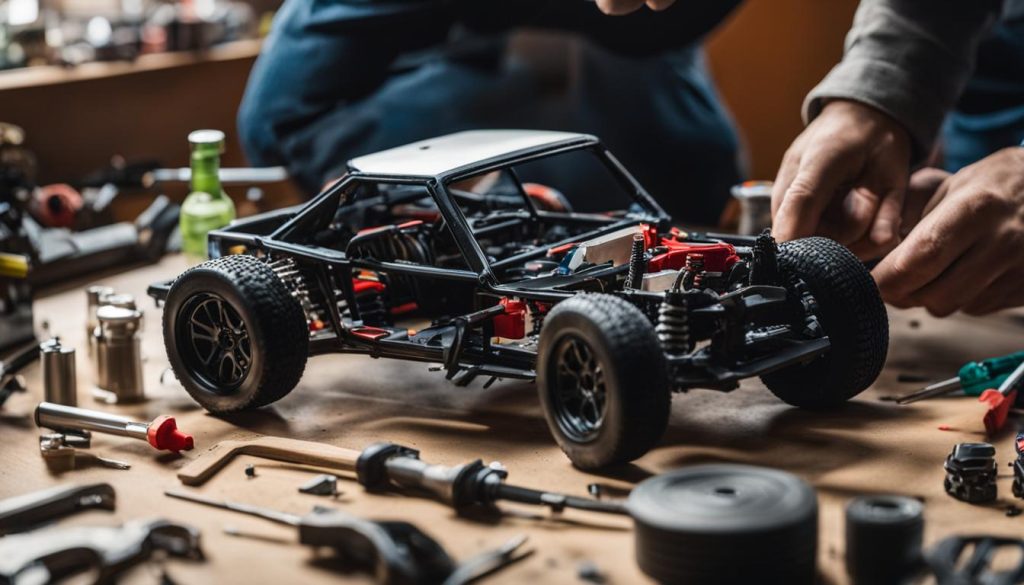
Recommended Accessories and Final Tips
To enhance your RC car experience and ensure its longevity, consider investing in recommended RC car accessories and following these final tips:
1. Spare Tires:
Always have spare tires on hand for quick replacements in case of damage or wear. This will minimize downtime and keep you on the track.
2. CA Glue:
CA glue, also known as cyanoacrylate adhesive, is a must-have for repairing broken parts, such as body panels or suspension components. It provides a strong and durable bond, ensuring your repairs last.
3. Investing in Quality:
When purchasing an RC car, invest in quality brands known for their durability and performance. Brands like Traxxas, Exceed, HPI, and Tamiya offer reliable options that will withstand the rigors of off-road driving.
4. Proper Maintenance:
Regular maintenance is crucial for the optimal performance and longevity of your RC car. Perform routine checks on the chassis, suspension, motor, and electronics. Clean your car thoroughly after each use to remove dirt and debris that may cause damage or affect performance.
By following these recommendations and practicing proper maintenance, you can enjoy a seamless RC car experience and prolong the life of your off-road vehicle.
| Recommended RC Car Accessories |
|---|
| Spare Tires |
| CA Glue |
Resources for Buying RC Cars and Parts
When it comes to purchasing RC cars and parts, you have plenty of options with various online retailers. Whether you’re looking for a brand new RC car or need specific parts and accessories to upgrade or repair your current one, these online retailers offer a wide selection to choose from:
- Traxxas: Traxxas is a well-known brand in the RC car industry, offering high-quality vehicles, parts, and accessories. They have an extensive range of off-road RC cars that cater to different experience levels and budgets.
- NitroRCX: NitroRCX is another trusted online retailer that specializes in RC cars and parts. They offer a variety of options from popular brands like Exceed, HPI, and Tamiya, ensuring you’ll find something that suits your preferences and needs.
- HPI Racing: HPI Racing is known for its high-performance RC cars that are built to withstand rough terrains. They have a wide range of off-road vehicles and genuine HPI parts to keep your RC car in top condition.
Before making a purchase, it’s important to compare prices and availability to ensure you’re getting the best deal. Additionally, take the time to read customer reviews and consider the reputation of the retailer to ensure a positive buying experience.
Remember, whether you’re just starting out or an experienced RC car enthusiast, buying from reputable online retailers like Traxxas, NitroRCX, and HPI Racing will give you access to a wide range of RC cars, parts, and accessories, allowing you to find everything you need to enjoy your hobby to the fullest.
Testimonial:
“I’ve been buying RC cars and parts from different online retailers for years, and I highly recommend checking out Traxxas, NitroRCX, and HPI Racing. They consistently offer competitive prices, fast shipping, and excellent customer service. I’ve always been satisfied with my purchases from these reputable retailers.”
– RC Car Enthusiast
Conclusion
Repairing off-road RC cars at home is not only a fulfilling endeavor but also a cost-effective way to maintain your hobby. This DIY guide has provided you with a comprehensive summary of how to diagnose and fix common issues, choose the right RC car and parts, and ensure proper maintenance for optimal performance.
By following the step-by-step instructions, you have learned how to troubleshoot problems like faulty on/off switches, dead batteries, loose wires, and slipped gears. Additionally, you have gained insight into selecting the right RC car brand, understanding different types of off-road RC cars, and choosing between electric or nitro-powered vehicles.
Remember, proper maintenance is crucial to prolonging the lifespan of your RC car. Regularly inspect and clean your car, invest in high-quality parts, and follow the user manual for any specific care instructions. Prioritizing safety is also essential, and if you ever encounter more complex issues, seeking professional help is recommended.
Now that you have the knowledge and skills to repair and maintain your off-road RC car, enjoy the thrill and excitement of this captivating hobby. Happy repairing!
FAQ
How can I repair my off-road RC car at home?
Follow our DIY guide for step-by-step instructions on repairing off-road RC cars at home.
What are some popular off-road RC car brands?
Some popular off-road RC car brands include Traxxas, Exceed, HPI, Tamiya, Team Associated, and Losi.
What types of off-road RC cars are available?
There are various types of off-road RC cars, including street cars, drift cars, buggies, truggies, and trucks.
Should I choose an electric or nitro RC car?
It depends on your preferences, budget, and level of experience. Electric RC cars are generally cheaper and require less maintenance, while nitro RC cars offer longer run times and a more realistic experience.
What is the difference between brushed and brushless motors?
Brushed motors are cheaper but less efficient and powerful compared to brushless motors. Brushless motors are more durable and efficient, but they can be more expensive.
How do I choose the right brushless motor for my RC car?
Consider factors such as brand, motor ratings (kv and t), compatibility with your RC car, and your budget when choosing a brushless motor.
What is the layout of an electric RC car?
The layout of an electric RC car may vary depending on the model. Familiarize yourself with the specific layout of your RC car and consult the user manual for additional information.
Should I use LiPo or Ni-Mh batteries for my RC car?
LiPo batteries provide longer run times and more power, while Ni-Mh batteries are cheaper and considered safer. Consider the capacity (mAh) and power delivery (C rating) when selecting the right battery pack for your RC car.
How can I troubleshoot common issues with my RC car?
To troubleshoot common issues, you can test the on/off switch, check batteries, inspect wiring, and address gear issues. Follow proper troubleshooting steps and consult the user manual or seek professional help if needed.
What are some recommended accessories for my RC car?
Some recommended accessories for your RC car include spare tires and CA glue for quick repairs. It’s also important to invest in a high-quality RC car, practice proper maintenance, and care for your vehicle.
Where can I buy RC cars and parts?
You can purchase RC cars and parts from online retailers such as Traxxas, Exceed, HPI, Tamiya, and more. Compare prices and availability before making a purchase, and consider the reputation and customer reviews of the retailer.
